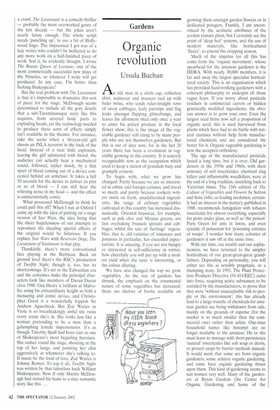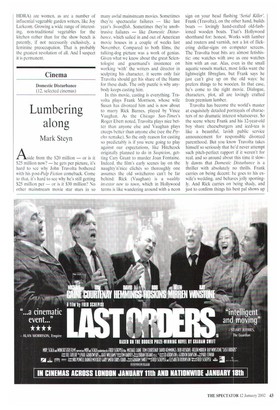Organic revolution
Ursula Buchan
An old man in a cloth cap, collarless shirt, waistcoat and trousers tied up with baler twine, who tends ruler-straight rows of savoy cabbages, leafy parsnips and flag leeks amongst flapping glitterbangs, and leaves his allotment shed only once a year to enter his prized produce in the local flower show; this is the image of the vegetable gardener still clung to by many people who are not themselves gardeners. But this is out of date now, for in the last 20 years there has been a revolution in vegetable growing in this country. It is scarcely recognisable now as the occupation which used to keep a nation of grandads busy and grumpily content.
To begin with, what we grow has changed. Partly because we are so interested in ethnic and foreign cuisines, and travel so much, and partly because cookery writers insist on fresh, unadulterated ingredients, the range of culinary vegetables cultivated in this country has increased dramatically. Oriental brassicas, for example, such as pak choi and Mizuna greens, are fast overtaking brussels sprouts and cabbages, whilst the sale of 'heritage' vegetables, that is, old varieties of tomatoes and potatoes in particular, has exceeded expectations. It is amazing, if you are not hungry or interested in self-sufficiency in winter, how cheerfully you will put up with a modest yield when the taste is interesting, or the colour alluring.
We have also changed the way we grow vegetables. As the size of gardens has shrunk, the emphasis on the ornamental nature of some vegetables has increased; there are shelves of books available on growing them amongst garden flowers or in dedicated potagers. Frankly, I am unconvinced by the aesthetic attributes of the cordon tomato plant, but I certainly see the point of 'deep bed' systems, and the use of modern materials, like horticultural 'fleece', to extend the cropping season.
Much of the impetus for all this has come from the 'organic movement', whose spearhead for the amateur gardener is the HDRA. With nearly 30,000 members, it is far and away the largest specialist horticultural society. This is an organisation which has provided hard-working gardeners with a coherent philosophy to underpin all those vague fears. If you worry about pesticide residues in commercial carrots or hidden genetically modified ingredients, the obvious answer is to grow your own. Even the largest seed firms now sell a proportion of organic seed; this is seed harvested from plants which have had to do battle with natural enemies without help from manufactured chemicals and are considered the better for it. Organic vegetable gardening is now the accepted orthodoxy.
The age of the manufactured pesticide lasted a long time, but it is over. Old gardeners in the 1950s and 1960s, with their armoury of soil insecticides, chemical slug killers and inflammable weedkillers, were at the end of a long tradition, stretching back to Victorian times. The 13th edition of The Culture of Vegetables and Flowers by Sutton and Sons (who, as leading seedsmen, certainly had an interest in the matter), published in 1908, recommends fumigation with tobacco insecticide for almost everything, especially for pests under glass, as well as 'the poison' Paris Green for ants in lawns, and even cyanide of potassium for 'poisoning colonies of wasps'. I wonder how many colonies of gardeners it saw off at the same time.
With our time, our wealth and our sophistication, we have returned to the simpler horticulture of our great-great-great grandfathers. Depending on personality, you will either see this as sensibly pragmatic, or a thumping irony. In 1993, The Plant Protection Products Directive (91/414/EEC) came into force, requiring active substances to be retrialed by the manufacturers, to prove that they were 'without unacceptable risk to people or the environment'; this has already lead to a large tranche of chemicals for amateur garden use being withdrawn from sale, mainly on the grounds of expense (for the market is so much smaller than the commercial one) rather than safety. One-time household names like benomyl are no longer available to the amateur. He or she must learn to manage with short-persistence 'natural' insecticides like soft soap or derris, or protect crops by barrier methods instead. It would seem that some are born organic gardeners, some achieve organic gardening, and some have organic gardening thrust upon them. This kind of gardening seems to suit women very well. Many of the gardeners at Ryton Gardens (the Centre for Organic Gardening and home of the HDRA) are women, as are a number of influential vegetable garden writers, like Joy Larkcom. Growing a wide range of interesting, non-traditional vegetables for the kitchen rather than for the show bench is patently, if not necessarily exclusively, a feminine preoccupation. That is probably the greatest revolution of all. And I suspect it is permanent.



























































 Previous page
Previous page